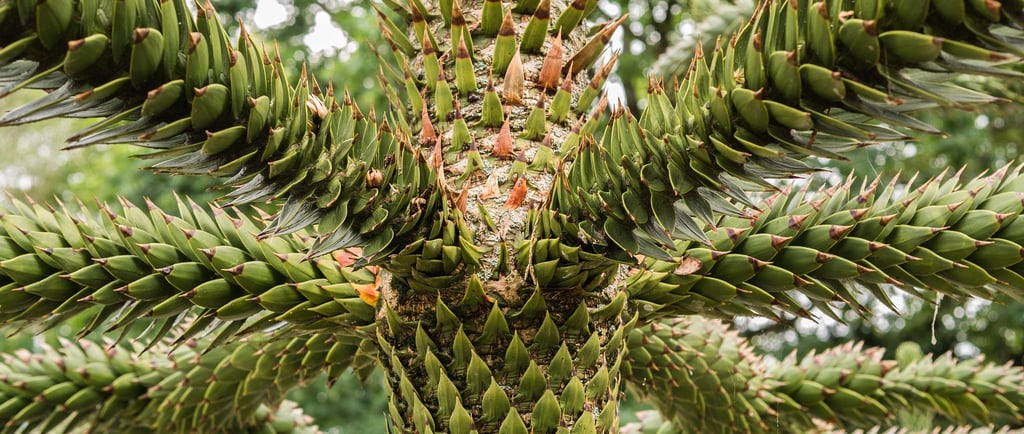🌲🦕 The Tree from the Age of Dinosaurs 🦖
🌲 A follow-up story rooted in the Biology Album ✨ This three from the Age of Dinosaurs invites children to marvel at a living fossil—an ancient tree with sharp, scale-like leaves that once guarded itself from roaming dinosaurs. With a spiny crown and a twisty trunk, this tree has outlived entire species and still stands tall in the misty forests of South America. 🦖🌿 Children explore how its prickly leaves serve as natural armor, why it is classified as a gymnosperm, and how its giant seeds—piñones—have nourished indigenous peoples for generations. From spiky defense to human tradition, this story invites wonder: “What else has survived since the time of the dinosaurs?” and “How do plants protect themselves when they can’t run away?” 🌎💭🌱.
BIOLOGY STORIES
6/1/20252 min read


Before the Earth had flowers… before bees buzzed or birds sang… there were trees. Ancient trees. Trees with scales instead of leaves and cones instead of fruits. One of those trees still lives today—and it’s so strange and spiky, even a monkey wouldn’t know how to climb it—not without getting poked!! 🐒
This is the Monkey Puzzle Tree, or Araucaria araucana—a living fossil from the time of the dinosaurs. 🦕🌍 You can find it growing high in the Andes mountains of Chile and Argentina, where its towering, symmetrical shape reaches for the sky like a giant green candelabra. But don’t try to hug it—this tree has a clever trick for protection…
Its leaves are not soft like maple or oak leaves. They’re thick, tough, and triangular, with sharp tips like armor! 🛡️🌿 Imagine the scales of a dragon, stacked around every branch, making sure no animal—even a hungry dinosaur—could nibble it without getting a prickly surprise.
In fact, some scientists believe these leafy defenses evolved long ago to protect the tree from ancient plant-eating giants, like the sauropods, 8 times bigger than the elephant, who may have wandered too close looking for a snack. And guess what? On the Timeline of Life, this spiky tree appears during the Jurassic period, around 150 million years ago, just when those giants roamed the Earth! 🌍🦖⏳
🌲Long ago, people in Chile told stories of how the Monkey Puzzle Tree guarded the mountains. Its cones were said to fall only for those who respected the forest. Some believed the tree held the memory of ancient times—when dinosaurs still walked the Earth and volcanoes ruled the horizon. 🌋🦕🌲
📜 Its scientific name, Araucaria araucana, comes from Araucanía, the land of the Mapuche people, the largest indigenous group of people who have cared for and honored this tree for thousands of years. To them, it’s not a puzzle—it’s a life-giving tree, because it produces huge cones filled with piñones (👏 pi 👏 ño 👏 nes)—nutrient-rich seeds similar to pine nuts. 🌰 These tasty seeds were traditionally gathered in baskets, roasted over fires, or ground into flour. They’ve nourished communities for generations. The word piñón comes from the Spanish root piña, meaning pine cone—because the seeds come from those mighty cones that look like armored fruit. 🍍➡️🌰
The Monkey Puzzle is part of a family of ancient gymnosperms, trees that produce naked seeds—not inside fruits like apples or cherries, but in open cones. It stood tall while the first birds flapped their wings and while continents slowly drifted apart. 🦜🌍 It is one of the few species from that time still with us today—a true survivor. And its sharp leaves? Still doing their job—guarding the branches with their ancient, armored leaves🌿🛡️ In fact, in Denmark, it’s called “Monkey’s Fear”—a playful name that matches its spiky, twisty branches that no monkey would want to climb ! 🐒😨🌿
💭I wonder.. What other plants use clever tricks to defend themselves? Some grow thorns, some release bad smells, some even produce chemicals that taste awful to animals! Can you find any plants in your environment that protect themselves like the Monkey Puzzle Tree?
With Montessori joy,
Vanina 😊

